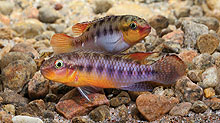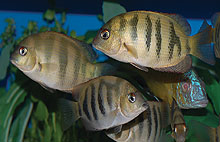Select date in side bar to go to a What's New of previous issues
| What's New
©by Laif DeMason
A noticeable up-tick in cichlid interest, especially wild items, came in the late spring and early summer this year. It seemed like everyone was asking for some kind of cichlid! I can’t say if it was because of the tax return season or the relatively low price of gasoline in the USA that eventually made hobbyists notice they had a little extra money to spend. Whatever the reason; no one who sells fish, retailer, importer, or exporter, was complaining! The end result was a whole lot of new cichlid fishes available to choose from. Here’s “what’s new” on the cichlid scene: |
Lake Tanganyika
Wild Tropheus are still king for most Tanganyika hobbyists. There is also a developing interest in featherfins and goby cichlids as well. Collections of Congolese Cyphotilapia frontosa and Tropheus are also fairly strong. Bred items, especially Cyprichromis varieties and shell dweller species seem popular as well.
 |
 |
 |
 |
Lake Malawi
Yikes, what happened? After a long dormant spell for interest in wild caught Malawi cichlids, hobbyists in the USA are actually asking for these cichlids over tank-raised or farm items. Maybe hobbyists are getting sick of seeing the usual multi-hybrid offspring from the Far East. Colorful yes, but limited in selection and, well, not as interesting as the wealth of species swimming in Lake Malawi!
 |
 |
 |
 |
West and Other Africa
 Several of the small Nanochromis species are found in the Democratic Republic of Congo fairly close to the capitol of Kinshasa. Recently there have been a few different varieties collected and exported from there. Pictured here is one that is often sold as Nanochromis sp. ‘kasai’, but is likely not from there and is Congochromis sabinae. Photo by O. Lucanus. |
 First nicknamed “pin-stripe damba”, Paretroplus menarambo have, as adults, narrow dark gray and light gray bars along with their red-edged caudal fin. Young, however, can exhibit a more striking and contrasting black barring against a whitish body color when several individuals are housed together. |